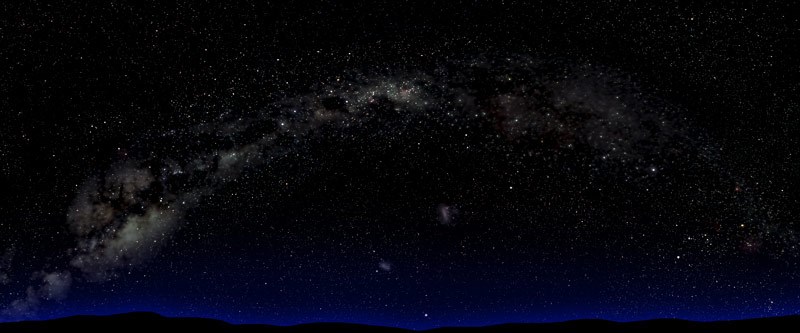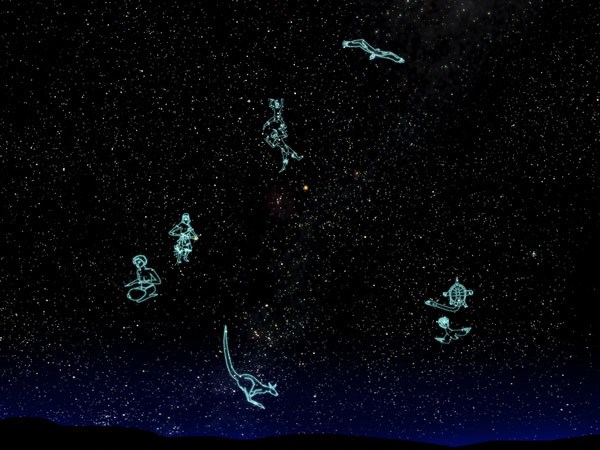
Planetarium Nights
Experience science and art in an evening of immersive cinema for adults 18 years and over.


Experience science and art in an evening of immersive cinema for adults 18 years and over.
Melbourne Planetarium has reopened, seven days a week, with a daytime Winter Holiday program and resumption of Friday Nights for adults.
| Date | Rise | Set | Day length | Solar noon§ |
|---|---|---|---|---|
| Thu 1st | 7:36 | 5:11 | 9:35 hrs | 12:23 |
| Sun 11th | 7:34 | 5:17 | 9:42 hrs | 12:25 |
| Wed 21st | 7:29 | 5:24 | 9:53 hrs | 12:26 |
| Sat 31st | 7:21 | 5:32 | 10:10 hrs | 12:26 |
§ When the Sun is at its highest, crossing the meridian or local longitude
| Phase | Date |
|---|---|
| Third Quarter | Fri 2nd |
| New Moon | Sat 10th |
| First Quarter | Sat 17th |
| Full Moon | Sat 24th |
| Third Quarter | Sat 31st |
This month’s Moon apogee (furthest from Earth) is on Tue 6th at 405,321 km and perigee (closest to Earth) is on Wed 21st at 364,520 km.
Mercury is moving closer to the sun and is not visible this month from Melbourne.
Venus is not easily visible this month. It can be seen for a brief time very low in the north-west at dusk but will set by 7.30pm.
Earth reaches aphelion this year on Tuesday July 6th (Melbourne time) which is its furthest distance from the Sun at 152.1 million km. Our planet’s largely elliptical orbit brought Earth to perihelion - closest to the Sun - last January 3rd at which time it was 5 million km closer. Earth’s orbit is determined by the gravitational influence of the Sun, the other planets, but above all by the moon which is so close to us, and significantly larger in relation to Earth than other moons are to their planets. Interestingly, Earth’s orbit slowly changes from elliptical to almost circular and then back again over a period of 100,000 years, which shows how dynamic planetary orbits can be over long-time scales.
Mars is briefly visible very early this month low in the north-west but during July it will set before sunset.
Jupiter, the third brightest object in the night sky after the moon and Venus, can be clearly seen from 9pm as it moves across from the eastern sky, across the north during the night, before fading in the west in the evening twilight around 7:15pm.
Saturn will precede its larger neighbour being visible from 7.30pm and will similarly move from east to north to west before it too disappears at dusk a little earlier.
July has no strong showers but peaking on the 27th-30th is the Southern Delta Aquarids in the constellation of Aqaurius, the water bearer (hence their name) which lies high in the northern sky. The meteors will radiate from close to the star Skat (Delta Auquarii), the fourth brightest star in the constellation. One or two hours before dawn provide the best time, and from a dark sky location there may be as many as 20 per hour.
In the west
Canis Major (and Sirius, brightest of the night time stars) and Canis Minor (and Procyon) are still visible but lower this month in the west and north-west respectively.
In the north
High in the north is Virgo and the star Spica, while Leo is in the north-west recognizable by its upside-down hook pattern of stars with the star Regulus.
In the east
Scorpius rises much higher in the south-east with the red-giant star Antares easily seen even from areas with city lights. Below and now fully revealed is the centaur-archer Sagittarius whose bow and arrow forms the famous asterism the ‘Tea Pot’.
In the south
The Southern Cross or Crux is high up directly south and, to the left, are the Pointers (Alpha and Beta Centauri which mark the front hooves of the other celestial centaur).
The billions of distant stars and numerous dark dust clouds of the Milky Way forms a broad band across the evening sky from east to west. From our southern perspective we enjoy a superb view of the galaxy quite different to most northern hemisphere locations.
Easy to see in the south-west are the intriguing irregularly shaped neighbouring galaxies, the Large and Small Clouds of Magellan, which are special features of our southern skies.
Visible are the bright stars Canopus in the south-west and Achernar closer to the horizon in the south.
First Peoples across Victoria and around Australia have diverse, ancient and rich traditions of night sky gazing and story-telling. What is visible in the evening over the course of the year often reflects the changing of the seasons, the significance and behaviour of animals and plants, the local landscape, and the regional environment and climate for specific areas of the country - all of which have cultural importance, relevance and meaning.
The broad expanse of the Milky Way stretches from east to west this month and includes from the Boorong tradition of north-west Victoria the full extent of the emu Tchingal. Its giant body is made of the large dark regions – the head being the Coal Sack nebula (adjacent to the Southern Cross), the two Pointers mark its long neck, and its body and legs reach far to the east. City light pollution means that to see Tchingal you will need to be view from a dark sky location.
In some First Peoples stories the vast expanse of dark and light areas of the Milky Way is the Warring - the campfire smoke of the lawgivers, the Nurrumbungittias, the ancient ones who created the land and live in the sky looking over the land and its people.
In the south two majestic brolgas, Kourtchin, are trumpeting and dancing. Their bodies are two Clouds of Magellan best seen away from city lights as well.
For the Boorong, the Southern Cross is Bunya the possum who sits in a tree at night fearful to come down, always cautious, and on the lookout for danger.
Two special stars feature in Boorong stories; the second brightest star at night, Canopus, which marks the male crow Wah, and Eta Carinae which is his partner the female crow Cullugulloric Wah. Both are important law givers and role models. Wah brought fire down to the people and Cullugulloric Wah has been seen by First Peoples to have faded over time (consistent with our understanding that this massive star has been shedding vast quantities of its gas into space).

Explore our page First Peoples of Australia Astronomy and the website Australian Indigenous Astronomy.
ISS orbits every 90 minutes at an average distance of 400 km appearing like a bright star moving slowly across the night sky. Here are some of the brightest passes expected this month over Melbourne and Central Victoria:
Tue 6th 6:45pm-6:48pm South-West to South-South-East
Fri 9th 6:00pm-6:04pm South-West to North-East
Wed 21st 6:52am-6:59am West-North-West to South-East
Thu 22nd 6:06am-6:12am North-West to South-East
1st 1770 closest pass to Earth of any known comet: Comet Lexell at 2.2 million km (roughly 5.5 times the moon’s distance).
4th 1054 Chinese and other astronomers witness the supernova explosion that produced the Crab Nebula 6500 light years away.
4th 2005 Deep Impact probe (USA) crashes into Comet Tempel 1 to analyse its composition.
4th 1868 birth of Henrietta Swan Leavitt who established the luminosity-period relationship of Cepheid variable stars allowing Edwin Hubble to show ‘nebulae’ were other galaxies beyond our own.
5th 1687 Isaac Newton’s Mathematical Principles of Natural Philosophy is published laying the groundwork for much of modern science.
7th 1959 Venus’ diameter is determined and its atmosphere analysed by its occultation of the star Regulus in Leo.
8th 2011 the space shuttle Atlantis (USA) is launched on the final mission for the shuttle program.
10th 1962 first communications satellite Telstar (USA) is launched as an experiment in trans-Atlantic communication.
11th 1979 Skylab 1 (USA) is destroyed during re-entry over Western Australia and scatters debris over a wide area.
14th 1965 Mariner 4 (USA) makes the first controlled flyby of Mars and returned the first close-up images of the planet.
15th 1975 Apollo-Soyuz Test Project mission occurs. An American Apollo module with three astronauts (launched with the last Saturn rocket) and a Soviet Soyuz craft with two cosmonauts rendezvous and dock in Earth orbit.
16th 1746 birth of Giuseppe Piazzi, discoverer of the dwarf planet Ceres in the asteroid belt. 16th 1969, Apollo 11 (USA) launches to moon for the first lunar landing 5 days later.
16th 1994 Jupiter is struck by over twenty fragments of Comet Shoemaker-Levy 9 with Earth-based telescopes and the Hubble Space Telescope observing the unique event.
20th 1969 Apollo 11 (USA) Moon landing when Lunar Excursion Module ‘Eagle’ touched down in the Sea of Tranquility.
21st 1969 first humans set foot on another world. At 12:39pm AEST Neil Armstrong becomes the first person to step onto the Moon and is followed 20 minutes later by Buzz Aldrin, while the third Apollo 11 astronaut, Michael Collins, remains in the Command Service Module ‘Columbia’ in lunar orbit. Armstrong and Aldrin are on the moon for 21hrs 36min.
22nd 1784 first use of parallax and hence calculation of the distance to a star by Friedrich Bessel.
23rd 1995 Alan Hale and Thomas Bopp discover comet now named after them.
23rd 1928 Vera Rubin born – famous for analysing rotation rates of galaxies.
24th 1969 first lunar landing mission, Apollo 11, ends with Command Module splashdown in the Pacific Ocean.
29th 2005 dwarf planets, Eris and Makemake, are announced leading to Pluto becoming a dwarf planets as well.
30th 1971 first Lunar Rover used on the moon in Apollo 15 Mission.
Museums Victoria acknowledges the Wurundjeri Woi Wurrung and Boon Wurrung Bunurong peoples of the eastern Kulin Nations where we work, and First Peoples across Victoria and Australia.
First Peoples are advised that this site may contain voices, images, and names of people now passed and content of cultural significance.